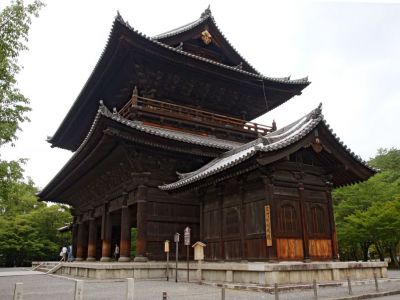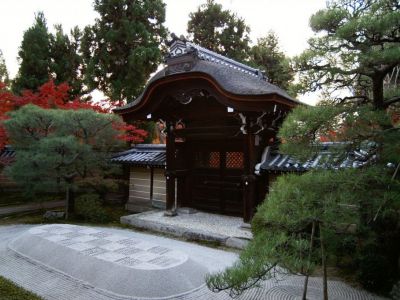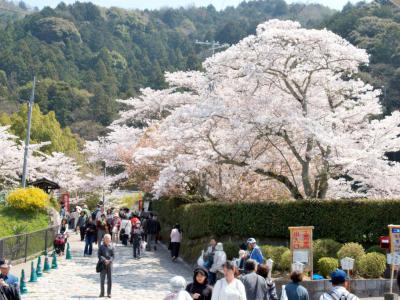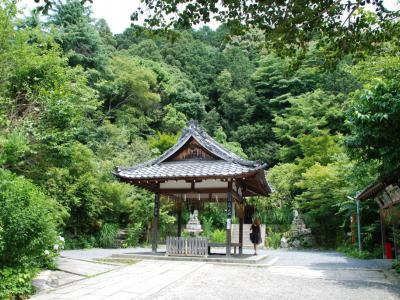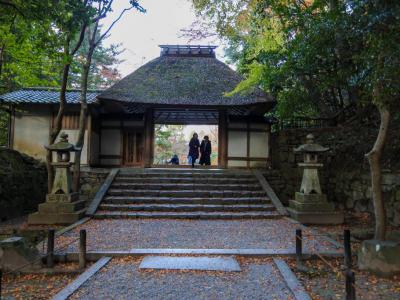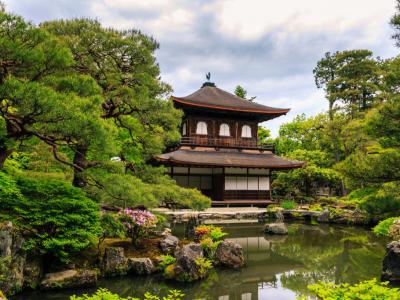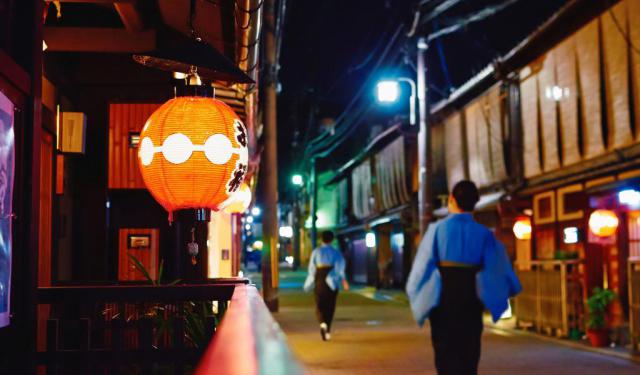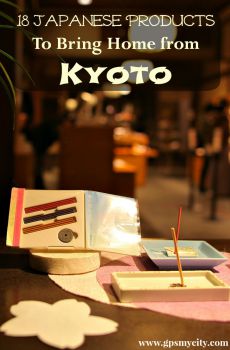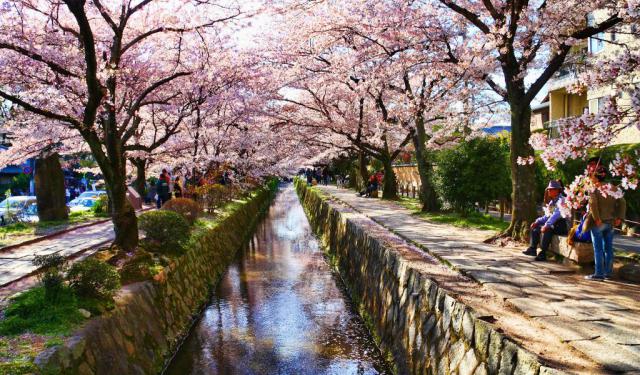
Walk on Philosopher's Path (Self Guided), Kyoto
The Philosopher's Path in Kyoto winds its way for about 2 km along the canal that carries water from Lake Biwa to the foothills. Lined with cherry trees, this picturesque walking trail was named in honor of the famed Japanese philosopher, Nishida Kitaro, who used to walk here as a part of his daily meditation in the first half of the 20th century. A popular spot for both locals and tourists, the path is perfect for a leisurely stroll surrounded by views that change through the seasons.
The trail starts at Nanzen-ji Temple, a historic Zen temple known for its grand architecture and serene gardens. As you move along, you will come across Eikan-do Zenrin-ji Temple, famous for its stunning autumn foliage and peaceful atmosphere.
Heading south on the Philosopher's Path, you'll encounter Otoyo Shrine, a small but charming shrine tucked away amidst the greenery. Further along, Daitoyo Bridge marks a scenic spot where you can pause and take in the tranquil surroundings. Crossing Sakurabashi Bridge, you'll find yourself near Honen-in Temple, a hidden gem known for its moss-covered grounds and traditional architecture.
Continuing on the path leads to Ginkaku-ji Temple, also known as the Silver Pavilion, which offers stunning views of the surrounding mountains and gardens.
As you meander along the Philosopher's Path, apart from traditional temples and shrines, you'll see huge koi fish, quaint local shops, and small cafes and galleries. If the weather is nice you may usually find artists selling painted postcards and the like at reasonable prices. We recommend that you start early rather than later because there are quite a few things there to get lost in! Take your time!
The trail starts at Nanzen-ji Temple, a historic Zen temple known for its grand architecture and serene gardens. As you move along, you will come across Eikan-do Zenrin-ji Temple, famous for its stunning autumn foliage and peaceful atmosphere.
Heading south on the Philosopher's Path, you'll encounter Otoyo Shrine, a small but charming shrine tucked away amidst the greenery. Further along, Daitoyo Bridge marks a scenic spot where you can pause and take in the tranquil surroundings. Crossing Sakurabashi Bridge, you'll find yourself near Honen-in Temple, a hidden gem known for its moss-covered grounds and traditional architecture.
Continuing on the path leads to Ginkaku-ji Temple, also known as the Silver Pavilion, which offers stunning views of the surrounding mountains and gardens.
As you meander along the Philosopher's Path, apart from traditional temples and shrines, you'll see huge koi fish, quaint local shops, and small cafes and galleries. If the weather is nice you may usually find artists selling painted postcards and the like at reasonable prices. We recommend that you start early rather than later because there are quite a few things there to get lost in! Take your time!
How it works: Download the app "GPSmyCity: Walks in 1K+ Cities" from Apple App Store or Google Play Store to your mobile phone or tablet. The app turns your mobile device into a personal tour guide and its built-in GPS navigation functions guide you from one tour stop to next. The app works offline, so no data plan is needed when traveling abroad.
Walk on Philosopher's Path Map
Guide Name: Walk on Philosopher's Path
Guide Location: Japan » Kyoto (See other walking tours in Kyoto)
Guide Type: Self-guided Walking Tour (Sightseeing)
# of Attractions: 8
Tour Duration: 2 Hour(s)
Travel Distance: 2.7 Km or 1.7 Miles
Author: emma
Sight(s) Featured in This Guide:
Guide Location: Japan » Kyoto (See other walking tours in Kyoto)
Guide Type: Self-guided Walking Tour (Sightseeing)
# of Attractions: 8
Tour Duration: 2 Hour(s)
Travel Distance: 2.7 Km or 1.7 Miles
Author: emma
Sight(s) Featured in This Guide:
- Nanzen-ji Temple
- Eikan-do Zenrin-ji Temple
- Philosopher's Path: South End
- Otoyo Shrine
- Philosopher's Path: Daitoyo Bridge
- Philosopher's Path: Sakurabashi Bridge
- Honen-in Temple
- Ginkaku-ji Temple
1) Nanzen-ji Temple
Once a slice of Japan's Imperial Palace, Nanzen-ji went through a fiery makeover during the Momoyama period (1570-1600) and emerged as a Zen temple. As the head honcho of Zen temples, it enjoys very high status and sits among some gorgeous old homes that scream "vintage Kyoto" minus the tourist frenzy of Gion. Keep your eyes peeled for wandering monks in their classic getup – straw hats and blue robes – and stroll in with a zen mindset to soak it all in.
Prepare to be wowed by the temple's colossal two-story gate – it's a behemoth, even by Japan's standards, and the view from its top is well worth traversing the stairs. Hojo Hall is another star attraction, with its sliding-door painting of a tiger quenching its thirst alongside other dazzling gold leaf artworks.
Meanwhile, the gardens here are the handiwork of the legendary landscaper Kobori Enshu from the early Edo era – trust us, they're worth the hype. And keep an eye out for the exquisite 130-year-old European-style aqueduct nearby. Picture-perfect brick arches with maple trees in the backdrop – it used to ferry water from Lake Biwa to Kyoto.
Perched on the mountains' edge, this spot screams 'chill vibes'. Whether you're up for a slow-paced morning or a full-blown day of exploration, Nanzen-ji has got you covered. Plus, general entry won't cost you a dime, though some spots might ask for a few yen depending on your interests.
Why You Should Visit:
A photographer's playground, with bridges, foliage, and waterworks at every turn.
The architecture of the buildings is, of course, very traditional and unique, and the brick aqueduct is very interesting to see.
Tips:
Feeling fancy? Hop on a rickshaw for a scenic spin around the area.
For a serene detour, slip under the aqueduct and veer right (by the little stream) to climb up to a beautiful temple that most tourists miss.
Prepare to be wowed by the temple's colossal two-story gate – it's a behemoth, even by Japan's standards, and the view from its top is well worth traversing the stairs. Hojo Hall is another star attraction, with its sliding-door painting of a tiger quenching its thirst alongside other dazzling gold leaf artworks.
Meanwhile, the gardens here are the handiwork of the legendary landscaper Kobori Enshu from the early Edo era – trust us, they're worth the hype. And keep an eye out for the exquisite 130-year-old European-style aqueduct nearby. Picture-perfect brick arches with maple trees in the backdrop – it used to ferry water from Lake Biwa to Kyoto.
Perched on the mountains' edge, this spot screams 'chill vibes'. Whether you're up for a slow-paced morning or a full-blown day of exploration, Nanzen-ji has got you covered. Plus, general entry won't cost you a dime, though some spots might ask for a few yen depending on your interests.
Why You Should Visit:
A photographer's playground, with bridges, foliage, and waterworks at every turn.
The architecture of the buildings is, of course, very traditional and unique, and the brick aqueduct is very interesting to see.
Tips:
Feeling fancy? Hop on a rickshaw for a scenic spin around the area.
For a serene detour, slip under the aqueduct and veer right (by the little stream) to climb up to a beautiful temple that most tourists miss.
2) Eikan-do Zenrin-ji Temple (must see)
A perfect blend of tradition and innovation awaits at this temple, and while there's a fee to get in, it's worth every penny. Don't let the unassuming exterior deceive you – once you step inside, prepare to be blown away as you navigate through, ascending higher and higher into the complex. Built into the hills, it's like stepping into a colossal treehouse – minus the rope ladders.
The scenery is a knockout, especially when the fall foliage is at peak! Picture-perfect Japanese maples and ginkgos flaunt a kaleidoscope of hues, from golden yellows to fiery red-oranges, with some verging on purple (head up to the two-story pagoda for the ultimate leaf-peeping experience!). And come late November, the landscape gets a magical makeover with evening illuminations.
The temple's unique feature is the statue of the Amida Buddha. Designated as an Important Cultural Property of Japan, this ain't your average Buddha – it gazes over its shoulder instead of straight ahead. Legend has it that back in 1082, Abbot Eikan had a divine encounter while chanting the Nembutsu – the statue sprung to life, urging him to "hurry up". The upper temple now houses the main icon, immortalizing Eikan's celestial rendezvous, with "Eikan-do" joining "Zenrin-ji" in honor of the devout monk.
Why You Should Visit:
The grounds are a feast for the eyes year-round, but if you happen to swing by Kyoto during the fall foliage fiesta, mark this spot on your must-visit list – whether it's day or night.
Tips:
Pause for a breather at the quaint rest area near the entrance – snag a seat and soak in the view framed by the wide window. Also keep an eye out for the 'suikinkutsu' – a quirky musical instrument that serenades you with soothing sounds when water is poured into it.
The scenery is a knockout, especially when the fall foliage is at peak! Picture-perfect Japanese maples and ginkgos flaunt a kaleidoscope of hues, from golden yellows to fiery red-oranges, with some verging on purple (head up to the two-story pagoda for the ultimate leaf-peeping experience!). And come late November, the landscape gets a magical makeover with evening illuminations.
The temple's unique feature is the statue of the Amida Buddha. Designated as an Important Cultural Property of Japan, this ain't your average Buddha – it gazes over its shoulder instead of straight ahead. Legend has it that back in 1082, Abbot Eikan had a divine encounter while chanting the Nembutsu – the statue sprung to life, urging him to "hurry up". The upper temple now houses the main icon, immortalizing Eikan's celestial rendezvous, with "Eikan-do" joining "Zenrin-ji" in honor of the devout monk.
Why You Should Visit:
The grounds are a feast for the eyes year-round, but if you happen to swing by Kyoto during the fall foliage fiesta, mark this spot on your must-visit list – whether it's day or night.
Tips:
Pause for a breather at the quaint rest area near the entrance – snag a seat and soak in the view framed by the wide window. Also keep an eye out for the 'suikinkutsu' – a quirky musical instrument that serenades you with soothing sounds when water is poured into it.
3) Philosopher's Path: South End (must see)
With the Nyakuoji Bridge as a starting point, the Philosopher Path's south-end offers much more than a stroll along the scenic canal.
About 20 meters to the left from the bridge, the SAYUU gallery for arts and crafts (open Thursday to Monday from 11 AM to 6 PM) has a tasteful selection of glass and pottery at pocket-friendly prices, while about 50 meters to the right you'll find the small and welcoming KUMANO NYAKUOJI-JINJA (open from 9 AM to 5 PM) – a hidden gem unspoiled by tourist crowds. Originally established in 1160, it enshrines the god of academic success and business prosperity. Legend has it that Yatagarasu, the mythical three-legged raven, dwells within, serving the god as a messenger. Keep an eye out for symbols of the three-legged ravel on the roof tiles and in the "Kumanogongen" lettering of the main shrine. A sanctuary of tranquility, the surrounding park (a conservation area) exudes peace and serenity, while the waterside provides a serene communion with nature throughout the year.
Those with a serious sweet tooth should head straight to the confectionery shop (and tea house) KANOU (10 AM – 8 PM) across the river, where they can enjoy their sweets and matcha without feeling rushed. Relaxing with freshly-baked delicacies while soaking in the sights of the Philosopher's Path is always a good idea!
About 20 meters to the left from the bridge, the SAYUU gallery for arts and crafts (open Thursday to Monday from 11 AM to 6 PM) has a tasteful selection of glass and pottery at pocket-friendly prices, while about 50 meters to the right you'll find the small and welcoming KUMANO NYAKUOJI-JINJA (open from 9 AM to 5 PM) – a hidden gem unspoiled by tourist crowds. Originally established in 1160, it enshrines the god of academic success and business prosperity. Legend has it that Yatagarasu, the mythical three-legged raven, dwells within, serving the god as a messenger. Keep an eye out for symbols of the three-legged ravel on the roof tiles and in the "Kumanogongen" lettering of the main shrine. A sanctuary of tranquility, the surrounding park (a conservation area) exudes peace and serenity, while the waterside provides a serene communion with nature throughout the year.
Those with a serious sweet tooth should head straight to the confectionery shop (and tea house) KANOU (10 AM – 8 PM) across the river, where they can enjoy their sweets and matcha without feeling rushed. Relaxing with freshly-baked delicacies while soaking in the sights of the Philosopher's Path is always a good idea!
4) Otoyo Shrine
Small, secluded, and easily explored in just half an hour, the Otoyo Shrine has guardians of a different kind – two mighty mice, breaking the mold of the typical Korean dogs seen at other Kyoto temples. Legend has it that these mice once saved the shrine's main deity from a fiery fate, a tale immortalized within the shrine's tiny wooden hall.
Observe closely as one mouse proudly presents a big sake bottle, believed to bestow luck, fertility, and, naturally, longevity upon worshippers, while the other holds a scroll symbolizing academic prowess. Adding to the whimsy are playful Chinese Zodiac figurines scattered throughout the grounds, alongside symbolic trees like camellia and weeping plums.
Similar to other spots along the Philosopher's Path, the unpretentious yet delightful gardens of Otoyo Shrine engender a sense of calm and serenity, welcoming visitors at no charge.
Observe closely as one mouse proudly presents a big sake bottle, believed to bestow luck, fertility, and, naturally, longevity upon worshippers, while the other holds a scroll symbolizing academic prowess. Adding to the whimsy are playful Chinese Zodiac figurines scattered throughout the grounds, alongside symbolic trees like camellia and weeping plums.
Similar to other spots along the Philosopher's Path, the unpretentious yet delightful gardens of Otoyo Shrine engender a sense of calm and serenity, welcoming visitors at no charge.
5) Philosopher's Path: Daitoyo Bridge
Kyoto has a lively coffee scene, unique to the city, that partly sustains its economic survival. Walking by the scenic Daitoyo Bridge, you might want to stop by the charming little "antique kimono shop" FUMIMARO – a perfect place for true vintage kimonos and yukatas – only to find that it has a café component as well! Given that they're mostly made of silk and hand-embroidered with golden thread, the kimonos come at a very good price, and the coffee on site is a nice bonus.
Further up the Philosopher's Path, KOMICHI is more of a 'kissaten'-style coffee shop with a traditional old-fashioned atmosphere and music. Here, amidst the aroma of freshly brewed coffee and tea, patrons can indulge in light noodle dishes, rice bowls, and an array of Japanese-style sweets. Exactly the type of establishment for which one wants to "wander off the path", with its front windows giving a pretty clear view of what's to be expected inside.
Further up the Philosopher's Path, KOMICHI is more of a 'kissaten'-style coffee shop with a traditional old-fashioned atmosphere and music. Here, amidst the aroma of freshly brewed coffee and tea, patrons can indulge in light noodle dishes, rice bowls, and an array of Japanese-style sweets. Exactly the type of establishment for which one wants to "wander off the path", with its front windows giving a pretty clear view of what's to be expected inside.
6) Philosopher's Path: Sakurabashi Bridge
A peaceful, philosophical walk wouldn't be complete without indulging in some succulent Japanese-inspired Philly cheesesteak and local libations, and The Diner by the bridge offers the perfect pit stop for just that. With its delectable yet reasonably priced fare (light enough to keep you energized for the trek), airy ambiance, and comfy seating, it's the ideal spot to recharge after all the walking. With welcoming English-speaking staff, it's an ideal spot to savor Western cuisine prepared with Japanese finesse!
Just a stone's throw away lies Gallery Takano, a tiny yet art-filled haven with a special focus on the intricate art of woodblock printing. The proprietors go the extra mile to share their knowledge and passion for the craft, making each visit a delightful learning experience. With all artworks neatly organized and offerings to suit every budget, it's a feast for the eyes and the soul.
Venturing further, you can also get a glimpse of the mausoleum dedicated to Reizei, Japan's sixty-third Emperor, whose brief reign from 967 to 969 was cut short by ill health. Lost and forgotten for several centuries, the tomb is little more than an overgrown plot of land that was given standard stone and wood accouterments in the late 19th century. There is a moss path around it, however, which makes for a pleasant walk (just be sure to clarify your intentions with the guard!).
Just a stone's throw away lies Gallery Takano, a tiny yet art-filled haven with a special focus on the intricate art of woodblock printing. The proprietors go the extra mile to share their knowledge and passion for the craft, making each visit a delightful learning experience. With all artworks neatly organized and offerings to suit every budget, it's a feast for the eyes and the soul.
Venturing further, you can also get a glimpse of the mausoleum dedicated to Reizei, Japan's sixty-third Emperor, whose brief reign from 967 to 969 was cut short by ill health. Lost and forgotten for several centuries, the tomb is little more than an overgrown plot of land that was given standard stone and wood accouterments in the late 19th century. There is a moss path around it, however, which makes for a pleasant walk (just be sure to clarify your intentions with the guard!).
7) Honen-in Temple
Constructed to honor Honen, the visionary behind the Jodo Shu sect of Zen Buddhism (1175), this temple remains one of Kyoto’s hidden gems – quietly beautiful and steeped in atmosphere. Covered with a lush coat of moss, its gateway leads visitors into a serene garden, complete with a picturesque stone bridge crossing a tranquil pond. And the best part? It's absolutely free, except during the first half of April and the first week of November, when the main hall opens its doors to coincide with blooming camellias and autumnal hues.
Passing through the gate with its quaint thatched roof (perfect for a snapshot), visitors encounter unique sand sculptures reflecting the changing seasons. Inside, the head priest's quarters feature sliding screens adorned with artwork by Kano School artists. One particularly captivating piece, "Soft Breeze Approaching", depicts the Pure Land amidst swaying willow trees. Nearby lies a graveyard, the eternal resting place of esteemed Japanese authors, including Jun'ichirō Tanizaki, a luminary of modern Japanese literature.
While the temple's grounds are interesting, it's the peaceful ambiance that truly enchants visitors. A leisurely stroll through the area, complete with ample photo opportunities, can be completed in under half an hour; however, the serene atmosphere may tempt you to linger a while longer, perhaps exploring the free art exhibitions showcasing paintings, photography, and more.
Tip:
Don't miss the hidden grotto tucked away amidst the sculpted mounds of sand and raked-gravel gardens.
Passing through the gate with its quaint thatched roof (perfect for a snapshot), visitors encounter unique sand sculptures reflecting the changing seasons. Inside, the head priest's quarters feature sliding screens adorned with artwork by Kano School artists. One particularly captivating piece, "Soft Breeze Approaching", depicts the Pure Land amidst swaying willow trees. Nearby lies a graveyard, the eternal resting place of esteemed Japanese authors, including Jun'ichirō Tanizaki, a luminary of modern Japanese literature.
While the temple's grounds are interesting, it's the peaceful ambiance that truly enchants visitors. A leisurely stroll through the area, complete with ample photo opportunities, can be completed in under half an hour; however, the serene atmosphere may tempt you to linger a while longer, perhaps exploring the free art exhibitions showcasing paintings, photography, and more.
Tip:
Don't miss the hidden grotto tucked away amidst the sculpted mounds of sand and raked-gravel gardens.
8) Ginkaku-ji Temple (must see)
Once the favorite retirement getaway of Yoshimasa, the eighth Ashigaka Shogun, who refined the famous tea ceremony tradition, this 15th-century Zen Buddhist temple – designated a UNESCO World Heritage Site in 1994 – is often called the 'little sibling' of Kinkaku-ji (Golden Pavilion), yet boasts even more scenic and exquisite gardens. The twist? Ginkaku-ji never actually got a silver makeover; it's the moonlight dancing on its dark exterior (originally coated in black lacquer) that gives it that shimmering effect. Moreover, the grounds comprise a famous 1.75-acre dry sand garden that, in turn, reflects the moon's glow and would appear like a "sea of silver sand". Crafted with perfect precision and featuring a Mount Fuji-inspired cone, this marvel alone is worth the trip!
From the "Moon-Viewing Platform", the landscape unfolds into a moss garden with ponds, islands, quaint bridges, streams, and a variety of foliage. Eventually, the walkway snakes up to a lookout point of the entire temple grounds and the sprawling city beyond. The path is beautifully solid underfoot, paved with a mix of large and small stones, and equipped with sturdy bamboo handrails for easy climbing.
Despite the crowds, you'll find moments of serenity here. And since the walk is one-way, there's no worry of jostling with fellow visitors.
Why You Should Visit:
This temple has it all: stunning gardens, bamboo grove, charming water features, and a walkway up to view the whole complex.
Tip:
For the best experience, visit early in the day or at sunset to enjoy the views in peace. And don't forget to check out the gift shops, where you'll find unique rabbit-themed treasures and fan souvenirs not found elsewhere in Kyoto.
From the "Moon-Viewing Platform", the landscape unfolds into a moss garden with ponds, islands, quaint bridges, streams, and a variety of foliage. Eventually, the walkway snakes up to a lookout point of the entire temple grounds and the sprawling city beyond. The path is beautifully solid underfoot, paved with a mix of large and small stones, and equipped with sturdy bamboo handrails for easy climbing.
Despite the crowds, you'll find moments of serenity here. And since the walk is one-way, there's no worry of jostling with fellow visitors.
Why You Should Visit:
This temple has it all: stunning gardens, bamboo grove, charming water features, and a walkway up to view the whole complex.
Tip:
For the best experience, visit early in the day or at sunset to enjoy the views in peace. And don't forget to check out the gift shops, where you'll find unique rabbit-themed treasures and fan souvenirs not found elsewhere in Kyoto.
Walking Tours in Kyoto, Japan
Create Your Own Walk in Kyoto
Creating your own self-guided walk in Kyoto is easy and fun. Choose the city attractions that you want to see and a walk route map will be created just for you. You can even set your hotel as the start point of the walk.
Arashiyama and Bamboo Grove Walking Tour
The Arashiyama district of Kyoto is slightly out of the way for tourists, but that means you can enjoy it more comfortably.
Undoubtedly, the most popular attraction here is the iconic Bamboo Grove, a mesmerizing forest of towering bamboo stalks that sway gently in the breeze, creating an ethereal atmosphere. This serene setting is a must-visit for travelers seeking tranquility amidst... view more
Tour Duration: 2 Hour(s)
Travel Distance: 3.4 Km or 2.1 Miles
Undoubtedly, the most popular attraction here is the iconic Bamboo Grove, a mesmerizing forest of towering bamboo stalks that sway gently in the breeze, creating an ethereal atmosphere. This serene setting is a must-visit for travelers seeking tranquility amidst... view more
Tour Duration: 2 Hour(s)
Travel Distance: 3.4 Km or 2.1 Miles
Higashiyama Walking Tour
Kyoto is a city catering to tourists, especially those who love history, religion, and, of course, Japanese culture. Many of Kyoto's attractions are found in the eastern part of the city, which itself is split into wards. One of them is the Higashiyama Ward, home to several famous temples, where the look and the feel of feudal-era Japan are still preserved.
One of Higashiyama's most... view more
Tour Duration: 1 Hour(s)
Travel Distance: 2.6 Km or 1.6 Miles
One of Higashiyama's most... view more
Tour Duration: 1 Hour(s)
Travel Distance: 2.6 Km or 1.6 Miles
Kyoto Shopping and Food Tour
The cultural capital of Japan, Kyoto is just as famous as a shopper’s paradise and, without a doubt, the best place in the country to buy traditional and modern Japanese goods. Souvenirs, food, bargains, and various “one-of-a-kind items” are all up for grabs here.
In addition to its shopping scene, Kyoto boasts a rich culinary heritage, from Michelin-starred restaurants to humble street... view more
Tour Duration: 1 Hour(s)
Travel Distance: 2.0 Km or 1.2 Miles
In addition to its shopping scene, Kyoto boasts a rich culinary heritage, from Michelin-starred restaurants to humble street... view more
Tour Duration: 1 Hour(s)
Travel Distance: 2.0 Km or 1.2 Miles
Gion District Walking Tour
Famed as one of the most mesmerizing parts of Kyoto, Gion has long been associated with traditional Japanese entertainment, stunning temples, geishas, and local eateries, ideal for whiling away a day in the ancient capital of Japan. This district forms part of the Higashiyama (“Eastern Mountain”) neighborhood.
Among its notable landmarks is the Minamiza Kabuki Theater, a venue where... view more
Tour Duration: 2 Hour(s)
Travel Distance: 2.8 Km or 1.7 Miles
Among its notable landmarks is the Minamiza Kabuki Theater, a venue where... view more
Tour Duration: 2 Hour(s)
Travel Distance: 2.8 Km or 1.7 Miles
Imperial Kyoto Walking Tour
The former capital of Japan, Kyoto is the city of tradition. During its heyday, Imperial Kyoto was the cultural and political heart of the country. At the heart of its historical landscape, there are several iconic landmarks, each bearing witness to the city's imperial past.
Nijo Castle, an architectural marvel renowned for its elegant design and elaborate gardens, boasts impeccably... view more
Tour Duration: 2 Hour(s)
Travel Distance: 4.1 Km or 2.5 Miles
Nijo Castle, an architectural marvel renowned for its elegant design and elaborate gardens, boasts impeccably... view more
Tour Duration: 2 Hour(s)
Travel Distance: 4.1 Km or 2.5 Miles
Useful Travel Guides for Planning Your Trip
18 Japanese Products To Bring Home from Kyoto
The old capital of Japan, the city of Kyoto has once again been the talk of the world lately, thanks to the bestselling "Memoirs of a Geisha" book and the namesake Hollywood blockbuster movie. Renowned for its impeccable craftsmanship, Japan has so much to amaze a foreign eye with. Many of...
The Most Popular Cities
/ view all
